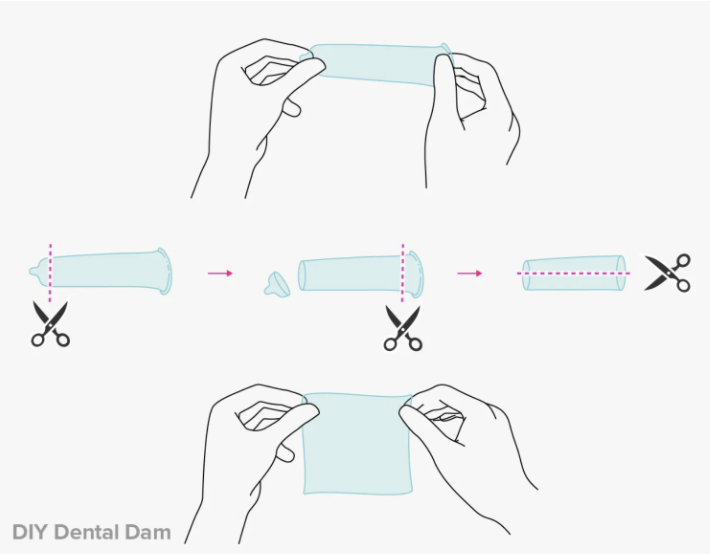Blowjobs, fellatio, giving head, eating out, cunnilingus, rimming. These are all terms used to reference oral sex which is any activity that involves the mouth, lips, or tongue, to stimulate the genitals, or anus of a sex partner. According to the CDC, more than 85% of sexually-active adults (ages 18 to 44) reported having oral sex at least once with a partner, showing just how common oral sex is.
The safest situation, other than abstaining from oral sex, is to only have oral sex if you are in a sexually monogamous relationship and you and your partner have both been tested recently. Not everyone is in this situation, and that should not deter you from having oral sex.
Oral sex can be extremely pleasurable, but it is important to take precautions since STI (Sexually Transmitted Infection) transmission can occur. Here are some critical things to know when engaging in oral sex.
1. A person can acquire an STI while participating in oral sex
According to the CDC, certain infections such as Chlamydia, Gonorrhea, Syphilis, Herpes, HPV, and in rare occasions, HIV, can be transmitted during oral sex. Furthermore, according to Avert, a charity providing accurate and trusted information about HIV and sexual health, notes that if you are engaging in oral-anal sex you could contract infections such as hepatitis A and E.coli. There is generally a very low risk of HIV infection from oral sex unless the receptive partner is living with an STI and has genital sores, or the partner providing oral stimulation has an STI and is symptomatic with sores, warts, or bleeding gums.
Not all STIs have symptoms and/or symptoms could be more subtle. The University of Florida's Student Health Care Center recommends “looking before you lick,” to check for lesions, growths, or unusual discharge in the genital area. If you notice any of these, hold off on oral sex until your partner gets tested since these symptoms may be due to STIs. Furthermore, according to Avert, infections can be passed on even if there are no obvious signs or symptoms, meaning you should be getting tested frequently.
If you are sexually active, the best practice is to get tested for STIs frequently. The CDC provides extensive guidelines for how often you should get tested based on your demographic, but it is advisable to get tested with each new partner for full transparency. Furthermore, many are unaware of window periods, the time it takes for an STI to read as positive after it has been transmitted. While some STIs only take a week to show up on a test, some may take up to four months.
It is always important to discuss your safer sex plans with your partner(s) including your test history and results, any sexual health concerns you are currently experiencing, and how this information will inform your plans for practicing safer [oral] sex. Greatist provides a helpful template on how you can speak to new partners about your sexual health status.
To learn more about STIs and how to talk about them head over to our recent blog post, Discussing Your STI Status and Practicing Safer Sex.
2. Use barrier methods for protection
A way to protect against STIs during oral sex is by using barrier methods such as condoms and dental dams. There are a variety of brands, styles, and flavors of barrier methods to choose from, which can be fun to mix it up. You and a sexual partner can get a variety of barrier methods and try out a new one every time you engage in oral sex! A good rule of thumb is to always have your barrier method of choice with you so that you can always engage in safer oral sex. Lastly, make sure to use a new barrier for each sex act.
External Condoms
If you are giving oral sex and your partner has a penis, we recommend using an external condom to prevent the transmission of STIs. To learn more about how to use external condoms, visit our Instagram for an IGTV demonstration led by ESW associate, Marnie Spiegel.
Dental Dams
If your partner has a vulva, or you are stimulating your partner anally, we recommend using a dental dam. To use a dental dam, hold one side against your partner’s vulva or anus and lick the other side, making sure to never turn the dam over. This graphic from Healthline shows how to use a dental dam.
Source: Healthline
Experts also recommend using a dental dam if the receptive partner is menstruating because menstrual blood can carry bacteria and viruses. Sometimes it can be difficult to find dental dams on short notice. Dental dams cannot always be found at gas stations, grocery stores, or doctors’ offices, so Healthline recommends going to a local adult store that sells pleasure devices, lube, and condoms or ordering them online at stores such as World Condoms or Undercover Condoms. There’s no need to worry because you can make your own by cutting a condom lengthways from bottom to top/the tip to create a single piece of material that can be used as a dam. This graphic from Healthline illustrates how you can create a dental dam out of a condom.
Source: Healthline
Watch this video from University of Chicago’s Wellness Center that teaches you how to convert an external condom into an effective dental dam!
Finger Condoms
Finger cots, or more commonly known as finger condoms, can be used when fingering a vagina or anus. Elizabeth Boskey at Very Well Health states that finger condoms can be an effective barrier method if you are only using one finger. They can reduce the risk of certain STIS and are often more comfortable than gloves. They note that finger condoms can be found in some first aid aisles of drugstores, but you can also purchase them online or make them by cutting a finger off of a latex glove. You can also experiment with different flavors of barrier methods, to excite your tastebuds and make safer oral sex more enjoyable - we recommend the strawberry flavor.
3. Brushing your teeth or using mouthwash before and after engaging in oral sex can lead to infection
You may want your breath to smell good before “going down” on someone, but brushing your teeth can actually increase your risk of contracting an STI. According to the University of Georgia’s Health Center, flossing and brushing your teeth can cause your gums to bleed, thus irritating them and making it easier for an infection to pass from one partner to another. In a 2017 interview with Shape magazine, endodontist Gary Glassman, D.D.S shared that you should only be rinsing your mouth out with water, nothing else, before and after having oral sex.
Oral hygiene is a necessary part of having safer oral sex. According to the CDC, poor oral health can lead to tooth decay, gum disease, bleeding gums, and oral cancer, thus making it easier for STIs to be transmitted. Make sure you are brushing and flossing regularly!
4. If you think you have the common cold, hold off on oral sex, as you may have an oral infection
It is important to note that some oral infections can be easily confused with the common cold. Assistant professor of clinical medicine at Northwestern Memorial Hospital in Chicago, Gil Weiss, M.D, reports that some symptoms of STIs (such as a sore throat, cough, fever, and enlarged lymph nodes in the neck) are similar to symptoms of a common cold. The University of Georgia’s Health Center recommends abstaining from oral sex if your partner has a cold sore on their mouth or they are living with sores, discharge, or unusual odors on their genitals as these may be signs of infection.
Oral sex is pleasurable, but can be made even more pleasurable if sexual safety is taken into account. If you are feeling nervous about having oral sex because you think you may be experiencing symptoms of an STI, we recommend you hold off on oral sex until you get tested. Keep these tips in mind as you engage in oral sex, but most importantly make sure you are having a pleasureful time!
TLDR:
A person can acquire an STI while participating in oral sex
Use barrier methods for protection
Brushing your teeth or using mouthwash before and after engaging in oral sex can lead to infection
If you think you have the common cold, hold off on oral sex, as you may have an oral infection

































